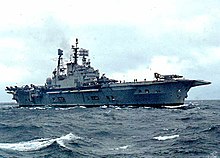
The Fleet Air Arm (FAA) is the naval aviation component of the United Kingdom's Royal Navy (RN). The FAA is one of five RN fighting arms. As of 2023 it is a predominantly "rotary" force, with helicopters undertaking roles once performed by biplanes such as the Fairey Swordfish. It operates the F-35 Lightning II for maritime strike and the AW159 Wildcat and AW101 Merlin for commando and anti-submarine warfare.
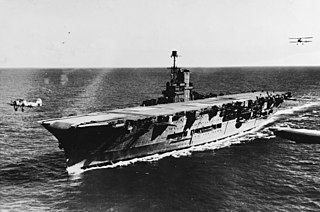
HMS Ark Royal was an aircraft carrier of the Royal Navy that was operated during the Second World War.

USS Forrestal (CVA-59), was a supercarrier named after the first United States Secretary of Defense James Forrestal. Commissioned in 1955, she was the United States' first completed supercarrier, and was the lead ship of her class. The other carriers of her class were USS Saratoga, USS Ranger and USS Independence. She surpassed the World War II Japanese carrier Shinano as the largest carrier yet built, and was the first designed to support jet aircraft.
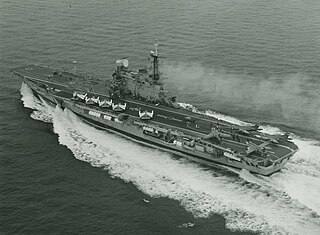
HMS Hermes was a conventional British aircraft carrier and the last of the Centaur class.
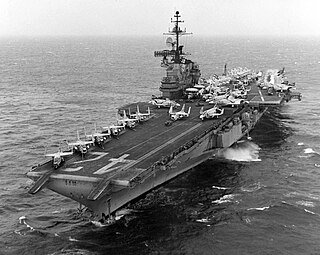
USS Franklin D. Roosevelt (CVB/CVA/CV-42) was the second of three Midway-class aircraft carriers. To her crew, she was known as "Swanky Franky," "Foo-De-Roo," or "Rosie," with the last nickname probably the most popular. Roosevelt spent most of her active deployed career operating in the Mediterranean Sea as part of the United States Sixth Fleet. The ship was decommissioned in 1977 and was scrapped shortly afterward. She was the first aircraft carrier of the United States Navy to be named in honor of a president of the United States.

HMS Illustrious was a light aircraft carrier of the Royal Navy and the second of three Invincible-class ships constructed in the late 1970s and early 1980s. She was the fifth warship and second aircraft carrier to bear the name Illustrious, and was affectionately known to her crew as "Lusty". In 1982, the conflict in the Falklands necessitated that Illustrious be completed and rushed south to join her sister ship HMS Invincible and the veteran carrier HMS Hermes. To this end, she was brought forward by three months for completion at Swan Hunter Shipyard, then commissioned on 20 June 1982 at sea en route to Portsmouth Dockyard to take on board extra stores and crew. She arrived in the Falklands to relieve Invincible on 28 August 1982 in a steam past. Returning to the United Kingdom, she was not formally commissioned into the fleet until 20 March 1983. After her South Atlantic deployment, she was deployed on Operation Southern Watch in Iraq, then Operation Deny Flight in Bosnia during the 1990s and Operation Palliser in Sierra Leone in 2000. An extensive re-fit during 2002 prevented her from involvement in the 2003 Iraq War, but she was returned to service in time to assist British citizens trapped by the 2006 Lebanon War.

The Blackburn Buccaneer is a British carrier-capable attack aircraft designed in the 1950s for the Royal Navy (RN). Designed and initially produced by Blackburn Aircraft at Brough, it was later officially known as the Hawker Siddeley Buccaneer when Blackburn became a part of the Hawker Siddeley Group, but this name is rarely used.

HMS Eagle was an Audacious-class aircraft carrier of the Royal Navy, in service 1951–1972. Until the arrival of the Queen Elizabeth-class aircraft carriers in the 21st century, she and her sister Ark Royal were the two largest Royal Navy aircraft carriers ever built.

HMS Ark Royal (R09) was an Audacious-class aircraft carrier of the Royal Navy and, when she was decommissioned in 1979, was the Royal Navy's last remaining conventional catapult and arrested-landing aircraft carrier. She was the first aircraft carrier to be equipped with angled flight deck at its commissioning; her sister ship, HMS Eagle, was the Royal Navy's first angle-decked aircraft carrier after modification in 1954. Ark Royal was the only non-United States vessel to operate the McDonnell Douglas Phantom at sea.

HMAS Melbourne (R21) was a Majestic-class light aircraft carrier operated by the Royal Australian Navy (RAN) from 1955 until 1982, and was the third and final conventional aircraft carrier to serve in the RAN. Melbourne was the only Commonwealth naval vessel to sink two friendly warships in peacetime collisions.

CVA-01 was a proposed United Kingdom aircraft carrier, designed during the 1960s. The ship was intended to be the first of a class that would replace all of the Royal Navy's carriers, most of which had been designed before or during the Second World War. CVA-01 and CVA-02 were intended to replace HMS Victorious and HMS Ark Royal, while CVA-03 and CVA-04 would have replaced HMS Hermes and HMS Eagle respectively.

HMS Ark Royal was the first ship designed and built as a seaplane carrier. She was purchased by the Royal Navy in 1914 shortly after her keel had been laid and the ship was only in frames; this allowed the ship's design to be modified almost totally to accommodate seaplanes. During the First World War, Ark Royal participated in the Gallipoli Campaign in early 1915, with her aircraft conducting aerial reconnaissance and observation missions. Her aircraft later supported British troops on the Macedonian Front in 1916, before she returned to the Dardanelles to act as a depot ship for all the seaplanes operating in the area. In January 1918, several of her aircraft unsuccessfully attacked the German battlecruiser SMS Goeben when she sortied from the Dardanelles to attack Allied ships in the area. The ship left the area later in the year to support seaplanes conducting anti-submarine patrols over the southern Aegean Sea.
Warship is a British television drama series produced by the BBC and broadcast between 1973 and 1977. The series was set contemporaneously and depicted life on board the fictitious Royal Navy frigate HMS Hero. Four series were produced with 45 episodes made in total.

800 Naval Air Squadron was a Royal Navy Fleet Air Arm carrier-based squadron formed on 3 April 1933 by amalgamating No's 402 and 404 Flights.

892 Naval Air Squadron was a carrier-based fighter squadron of the British Royal Navy's Fleet Air Arm. It was formed in 1943, flying Grumman Martlets, and was the only operational Fleet Air Arm squadron to fly the McDonnell Douglas Phantom FG.1.
801 Naval Air Squadron (NAS) was a Fleet Air Arm squadron of the Royal Navy formed in 1933 which fought in World War II, the Korean War and the Falklands War.
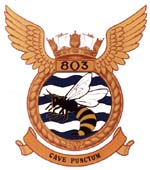
803 Naval Air Squadron was a Royal Navy Fleet Air Arm squadron.

809 Naval Air Squadron, nicknamed the Immortals, is a squadron of the Fleet Air Arm of the United Kingdom. It was first formed in 1941 and flew in the Soviet Union, the Mediterranean and the Far East during the Second World War. After active service during the Suez Crisis, 809 was disbanded in 1959. Reformed in 1963 to fly Blackburn Buccaneers, the squadron was disbanded briefly in 1965–66, and then again in 1978. A brief period during the Falklands War saw 809 reformed to bring Sea Harrier FRS.1 aircraft south to the UK task group and to fly from HMS Illustrious.

The Fairey Gannet AEW.3 is a variant of the Fairey Gannet anti-submarine warfare aircraft intended to be used in the airborne early warning (AEW) role on aircraft carriers of the Royal Navy. It was introduced to service in 1959 to replace the obsolete Douglas Skyraider, and was intended as an interim solution until the planned introduction of a new, purpose built AEW platform for use on the planned CVA-01 aircraft carriers. Neither the new aircraft carriers nor the new AEW aircraft were proceeded with, and the Gannet AEW.3 remained in service until the last aircraft carrier that could operate it was retired in 1978.

The United Kingdom (UK) operated the McDonnell Douglas F-4 Phantom II as one of its principal combat aircraft from 1968 to 1992. The UK was the first export customer for the F-4 Phantom, which was ordered in the context of political and economic difficulties around British designs for the roles that it eventually undertook. The Phantom was procured to serve in both the Royal Navy's Fleet Air Arm (FAA) and the Royal Air Force (RAF) in several roles including air defence, close air support, low-level strike and tactical reconnaissance.
